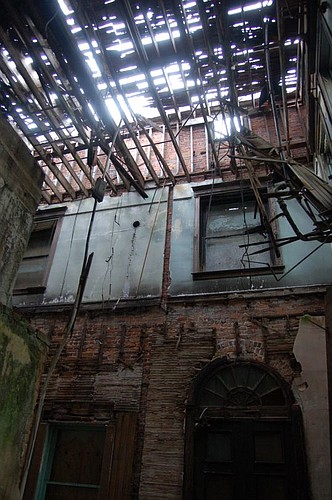
Water has been a devastating intruder, seeping through a roof in disrepair.
Remnants of former tenants remain, but are lost in a mix of dirt, dank and neglect.
The Guaranty Trust & Savings Bank building has seen better days. Better decades.
Yet, its bones are intact.
The Downtown landmark has a design that produces an image of “stability, dignity and security” — the description a city board gave the 101 E. Bay St. building when seeking historic designation last year.
One might not be able to see those qualities after taking a peek inside, but they are there.
“The building has good materials,” said Jacksonville historian Wayne Wood. “If it were brought back to its pristine, historic shape, it would be everything they describe when it was built.”
Investors will have their chance — the Bostwick Building hits the auction block Monday, months after the city foreclosed on it.
It rose from the ashes once. Now historic preservation and Downtown advocates are hoping for another rebound.
From the ashes
The building that sits at Bay and Ocean streets has been there for more than a century, but it’s not the original structure.
The site was home of First National Bank, built in 1880. William Bostwick, the future mayor and building’s namesake, served on the bank’s board of directors, but he wasn’t the only famous one.
General Francis Spinner, the former U.S. Treasurer for presidents Abraham Lincoln, Andrew Johnson and Ulysses S. Grant, also served.
That building wouldn’t have a long history. Years later, the Great Fire of 1901 would destroy it and many others in one of the defining periods in Jacksonville’s history.
The bank was rebuilt in 1902 with a design that reflects traditional, classical bank architecture — arched windows, decorative hood, masonry pilasters, large open spaces, limestone and brick.
First National failed the next year and was purchased by Guaranty Trust & Savings, the official name of the building. The first vice president of the company was Bostwick’s son, William Jr.
A $40,000 expansion in 1919 doubled the building to its current size. Three years later, Guaranty Trust failed.
It closed, leading way for yet another bank to step in.
Brotherhood State Bank occupied the site until its head cashier, Thomas Hendricks, committed suicide in the building in 1924. The bank never reopened.
Seven years later, Bostwick Jr. repaid the depositors who lost money when the bank closed. In all, he handed back $130,000 to 875 people.
And he did it in person at the bank.
Famous inhabitant
After the banking years, the building served as professional offices for years.
Perhaps its most famous was an architect. One who had nothing to do with the building, but much to do with rebuilding Jacksonville.
Architect Henry Klutho called the Bostwick Building his office from 1944-60.
He moved to Jacksonville shortly after the Great Fire, helping design what became a blank, burnt canvas. His influence can be seen in the St. James Building, which houses City Hall, the Dyal Upchurch Building and many residences.
Slow demise
The Bostwick family has owned or been involved with the building for more than a century.
Yet, despite its tenure as one of Jacksonville’s older buildings, it’s been abandoned for years.
The jaguar murals the building is now most associated with became a fixture before the Jacksonville Jaguars had their first game in 1995. The Downtown Council of the JAX Chamber has for years used it as a meeting spot to paint paw prints along Bay Street toward the sports complex.
But mostly, it’s had no action, no investment.
Time and a lack of attention brought water intrusion through a broken roof, hastening the interior deterioration.
The physical problems mounted, leading the city in 2012 to start issuing $100-a-day fines because the structure didn’t meet building codes.
Costly repairs and the rolling fines led the Bostwick family to seek a demolition permit in August 2012. The city’s Historic Preservation Commission countered with a push to denote it historic, setting off a battle that didn’t end for more than a year.
The family argued registering it as historic infringed on property rights, while history advocates said the building should be saved.
The City Council Land Use and Zoning Committee took up the demolition vs. preservation issue during much of 2013. During that time, several interested buyers tried to strike a deal with the family to buy the property but to no avail.
The closest was between the family and a group led by Jacques Klempf, CEO of Dixie Egg Co. The idea was to rehabilitate the building and turn it into a restaurant. A $325,000 deal was struck but not completed after a standing lawsuit with a neighboring business couldn’t be settled.
The main roadblock? Water intrusion.
After the deal fell through, council passed the historic landmark designation and declined the demolition permit.
During it all, those $100-a-day fines kept accumulating.
The day after council ruled, the city foreclosed on the Bostwicks, who did not return calls for this story.
On the block
The city is owed $78,774, which consists of the rolling fines the Bostwicks owe, plus legal fees.
That will be the starting point when the building goes to auction at 11 a.m. Monday.
If a bid is more than the amount owed, the city will receive its money and the Bostwicks anything over. The purchaser would take over and rehabilitate within the confines of historic preservation guidelines and review.
If there are no bids, the city takes control.
“People fix buildings way worse than that,” said Wood. “It’s an icon of its time.”
Klempf said Thursday he has registered to bid on Clerk of Court’s website, but is unsure if he’ll be bidding Monday morning.
Whether he or anyone else will be a part the next chapter in the building’s history won’t be known until then.
@writerchapman
(904) 356-2466